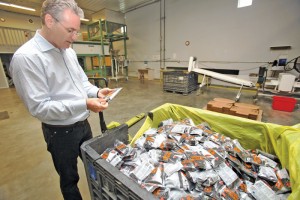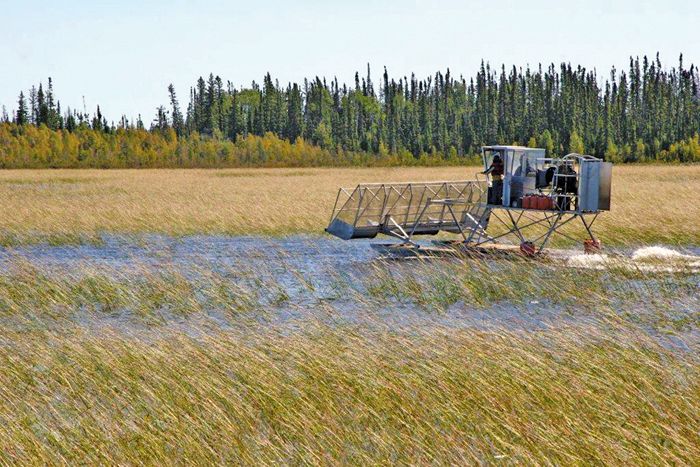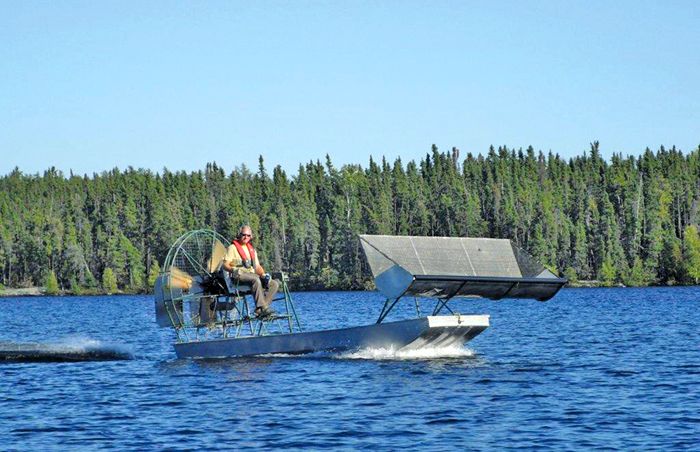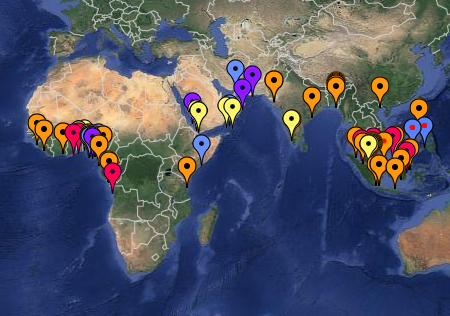airboats harvest wild rice
published: 16 Oct 2014
by: Shannon VanRaes
Wild rice has been harvested in northern Manitoba for thousands of years, and now airboats are used for harvesting as demands may outstrip supplies with the grain’s increase in popularity.
Call it too much of a good thing.
Wild rice needs plenty of water to grow, but heavy rains and high water coupled with cool temperatures has hit producers hard this season, particularly in northwestern Manitoba and northeastern Saskatchewan.
“There’s this little pocket that covers the majority of Canadian production and they had a terrible year. Some of the people I was inspecting, they were going to harvest nothing,” said Stuart McMillan, an independent organic inspector.
“It’s hard to imagine with an aquatic plant, but they got drowned out,” he said. “At some stages of growth it’s really sensitive to rapid fluctuations in water levels.”
Ideally, wild rice needs between three and five feet of water as a growing medium.
“We’ve been calling it a perfect storm,” said Tracy Wheeler-Anderson, owner of Naosap Harvest in Cranberry Portage. “It’s just been a very, very odd year. The water table was high last fall, then we had an abnormal amount of snow and then we had an abnormal amount of rain, so come spring the water levels were way higher than what they normally are.”
A cool spring also meant rice plants grew slowly, and two days of frost in mid-September brought the harvest to an end.
“We harvested maybe a third of what we would normally get, maybe even a little less,” Wheeler-Anderson said.
Just outside of the City of Winnipeg’s boundaries, you’ll find Shoal Lake Wild Rice Ltd., one of the largest processors of wild rice in Canada, according to Manitoba Agriculture, Food and Rural Development.
Murray Ratuski, who heads the operation, said they’re already feeling the effects of the light harvest.

Murray Ratuski of Shoal Lake Wild Rice Ltd. at the company’s processing facility in the Rural Municipality of Springfield.
“We’ve already implemented price increases and advised our customers that it’s a lean year,” he said.
Most of the company’s wild rice supply is coming from Saskatchewan this fall, although it also has suppliers in Manitoba, and in Ontario where the company was founded in 1935.
Consumer interest in wild rice had risen dramatically in the last eight decades, often outpacing supply.
“Demand is on the increase, there’s lots of interest, and export interest has increased significantly over the years. But supply is always an issue,” said Ratuski. “God grows it, First Nations pick it, we process it.”
At least that’s how it works in Canada.
South of the border, the demand for so-called wild rice has been met through intensive agriculture, with paddy production taking place in California and Minnesota. However, ongoing drought conditions in California has cut production there by as much as 25 per cent, according to U.S. media reports.
American wild rice is often sold in Canadian stores, but Wheeler-Anderson said there are noticeable differences between the two, particularly when it comes to kernel length.
“It’s too bad that they all end up having the same name, but consumers are becoming more educated; they are looking for products that say Canadian… and lake grown,” she said. “Then you know right away you’re going to get different product.”
Ratuski said he wouldn’t want to give anyone the impression that one wild rice is better than another, but agreed that they are different.
McMillan is less diplomatic about the qualities of paddy-grown wild rice, noting it’s generally destined for processed foods.
“It’s poor quality, it doesn’t have the size or depth of colour; it’s kind of like the feed grain of the wild rice world,” said the inspector.
But increasing the supply of wild rice harvested from Canadian lakes wouldn’t be easy. Most comes from Crown lands, located in remote, northern locations.
“Some of our lakes are so isolated we’re breaking trail just to get a quad in there to get the loads of rice out,” Wheeler-Anderson said, adding a bag of wild rice from Naosap Harvest is handled between 11 and 15 times before reaching the customer.
“We hear people say, oh, it’s so expensive… and I’m thinking, you guys really have no idea what goes into it, we can’t drain the lake and take a combine in there,” she said.
Prices will continue to increase as stocks tighten, she added. Already green wild rice is selling between $1.10 and $1.40 per pound. It takes approximately two pounds of green rice to make one pound of finished wild rice — the kernels are harvested at 80 per cent moisture and dried down to eight per cent before being sold or stored.
But it may still be some time before consumers feel the impact.
Neechi Commons in Winnipeg is a go-to location for many when it comes to wild rice, but produce manager Iain Brynjolson said that so far they haven’t had to increase prices.
“We have two suppliers and we’ve been waiting for an order from one of them for a while, but they haven’t confirmed they’ve had a shortage yet,” he said.
The north-end grocery store sells nearly 400 lbs. of broken wild rice and 220 lbs. of whole grain wild rice every three to four weeks, with seasonal increases around Christmas and Thanksgiving.
Wheeler-Anderson said new studies on the nutritional value will likely continue to boost the grain’s appeal.
“One recent study put its antioxidants at blueberry levels,” she said, adding that wild rice also appeals to those looking to buy local, natural foods.
Back at Shoal Lake Wild Rice, Ratuski noted that wild rice is being featured in more products, including the specialty mixes the company manufactures and sells under brands such as Floating Leaf and Canoe Wild Rice.
Packaging a variety of mixes for a wide range of customers also gives the company flexibility and options when wild rice supplies are tight, he said.
And stocks won’t rebound until next fall, provided there is a good harvest in 2015.
“So it’s been a bit of a scramble. Everybody is all over the place trying to get as many pounds as they can,” Wheeler-Anderson said.





